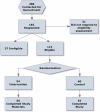Conjoint analysis versus rating and ranking for values elicitation and clarification in colorectal cancer screening
- PMID: 21870192
- PMCID: PMC3250548
- DOI: 10.1007/s11606-011-1837-z
Conjoint analysis versus rating and ranking for values elicitation and clarification in colorectal cancer screening
Abstract
Purpose: To compare two techniques for eliciting and clarifying patient values for decision making about colorectal cancer (CRC) screening: choice-based conjoint analysis and a rating and ranking task.
Methods: Using our decision lab registry and university e-mail lists, we recruited average risk adults ages 48-75 for a written, mailed survey. Eligible participants were given basic information about CRC screening and six attributes of CRC screening tests, then randomized to complete either a choice-based conjoint analysis with 16 discrete choice tasks or a rating and ranking task. The main outcome was the most important attribute, as determined from conjoint analysis or participant ranking. Conjoint analysis-based most important attribute was determined from individual patient-level utilities generated using multinomial logistic regression and hierarchical Bayesian modeling.
Results: Of the 114 eligible participants, 104 completed and returned questionnaires. Mean age was 57 (range 48-73), 70% were female, 88% were white, 71% were college graduates, and 62% were up to date with CRC screening. Ability to reduce CRC incidence and mortality was the most frequent most important attribute for both the conjoint analysis (56% of respondents) and rating/ranking (76% of respondents) groups, and these proportions differed significantly between groups (absolute difference 20%, 95% CI 3%, 37%, p =0.03). There were no significant differences between groups in proportion with clear values (p = 0.352), intent to be screened (p = 0.226) or unlabelled test preference (p = 0.521)
Conclusions: Choice-based conjoint analysis produced somewhat different patterns of attribute importance than a rating and ranking task, but had little effect on other outcomes.
References
-
- Sheridan SL, Harris RP, Woolf SH. Shared Decision-Making Workgroup of the U.S. Preventive Services Task Force. Shared decision making about screening and chemoprevention. A suggested approach from the U.S. Preventive Services Task Force. Am J Prev Med. 2004;26(1):56–66. doi: 10.1016/j.amepre.2003.09.011. - DOI - PubMed
-
- O’Connor AM, Bennett CL, Stacey D, Barry M, Col NF, Eden KB, et al. Decision aids for people facing health treatment or screening decisions. Cochrane Database Syst Rev. 2009;8(3):CD001431. - PubMed
-
- Pignone M, Harris R, Kinsinger L. Videotape-based decision aid for colon cancer screening. A randomized, controlled trial. Ann Intern Med. 2000;133(10):761–9. - PubMed
-
- Elwyn G, O’Connor A, Stacey D, Volk R, Edwards A, Coulter A, et al. Developing a quality criteria framework for patient decision aids: online international Delphi consensus process. BMJ. 2006;333(7565):417. doi: 10.1136/bmj.38926.629329.AE. - DOI - PMC - PubMed
Publication types
MeSH terms
Grants and funding
LinkOut - more resources
Full Text Sources
Medical
Miscellaneous


